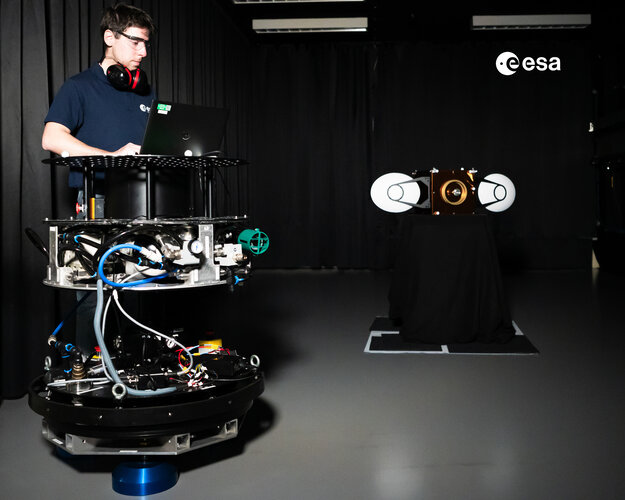A floating platform hovers 15 micrometres above Europe’s flattest floor, slowly circling a satellite model in the centre of the room, following a path generated by AI. The walls are covered with black curtains, all lights are switched off, and a single lamp illuminates the scene, simulating the Sun.
Lorenzo Capra, visiting PhD researcher from Politecnico di Milano, is testing a software for spacecraft trajectory optimisation.
“A camera mounted on top of the floating platform acquires images of its target, a satellite mock-up, as the platform makes its way around it,” Lorenzo explains. “The images are then fed into the program I’m testing, which is able to reconstruct a 3D model of the target.
“Technologies like this one enhance performance and autonomy of operations that involve approaching an unknown and uncooperative object in space. This means, for example, facilitating future in-orbit servicing operations, such as extending the life of existing spacecraft by repairing or refuelling them,” Lorenzo adds.
To test the system in conditions resembling space as closely as possible, Lorenzo made use of the ORBIT facility at ESTEC, European Space Agency’s technical heart.
The scene has been set to simulate the darkness of space, with Sun as the only source of light, and the lab’s satellite model contains characteristic satellite surface materials, including multi-layer insulation and communication antennas, to reflect this light as realistically as possible.
ORBIT is part of ESA’s Orbital Robotic Laboratory and consists of a 43 m2 ultra-flat floor – the height difference between its lowest and highest points is less than a millimetre.
The facility operates similarly to an air hockey table – its testing platforms are equipped with air bearings, which create a stable air gap between the platforms and the floor.
This air gap, thinner than a strand of hair and so hardly visible to the human eye, allows the platforms to move across the floor without any friction, reproducing the state of weightless free-floating in two dimensions.
Lorenzo’s trajectory-optimising software guides the floating platform around its target, commanding a system of thrusters and a reaction wheel to adjust its path – similarly to how a real spacecraft operates.
ORL engineer Jules Noirant comments: “The unique combination of ORBIT and our floating platforms allows industries and research institutions to test and validate new systems in a microgravity-simulating environment. This includes payloads for in-orbit interactions, as well as various Attitude and Orbit Control Systems (AOCS) for spacecraft.
“The facility enables our partners to shape future technologies in a cost-effective way, while benefiting from the know-how of our experts.”
[Image description: This is a photograph of a satellite model that is positioned in the centre of a dark room. To the left of it, a device covered in wires is being operated by an engineer, fully focused on the laptop screen in front of him. The whole scene is illuminated by a single lamp placed behind the camera that took this image, putting focus on the satellite model and the wire-covered device, cloaking the rest of the room in darkness.]

 Image:
Hovering over Europe’s flattest floor with AI
Image:
Hovering over Europe’s flattest floor with AI